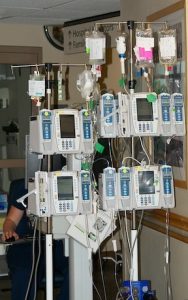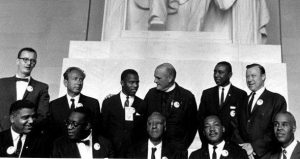Aug 26 2020
From Time to Time: (Hydroxy)Chloroquine
From Time to Time
History does not repeat itself,
But it certainly likes to rhyme.
(Hydroxy)Chloroquine:
From Himmler’s Poison to Trump’s Miracle Cure
by Anna Rosmus
Throughout history, malaria has played a prominent role in the fate of nation-states and military actions.[1] World War II was no exception. The United States Army faced malaria, both at home and abroad. German troops contracted it in Greece, in the Pinsk marshes, and in North Africa.[2] Throughout WWII, an average of 100 German soldiers died per hour.[3]
Malaria was not to incapacitate millions more.[4] In 1934, when Hans Andersag worked for Bayer IG Farbenindustrie in Elberfeld, Germany, he discovered chloroquine (aka Resochin).[5] It was deemed too toxic for human use.[6] Two years later, Andersag developed Sontochin, a somewhat safer derivative.
On January 27, 1942, Reichsführer SS Heinrich Himmler spent five hours with his visitors, retired Professor Claus Schilling and Reichsärzteführer Leonardo Conti.[7] Afterwards, he provided Schilling with an experimental malaria research station at the Dachau concentration camp. Of an estimated 1,200 intentionally infected inmates, many were then injected with synthetic malaria drugs, “with high and sometimes lethal doses.”[8] At least 120 of these victims were priests.
When Himmler proposed adding an SS-institute exploring insects, the “Ahnenerbe“ organization established one directly east of the prisoners’ compound. New research suggests that dropping malaria-infected mosquitoes over enemy territory as biological weapons might have been the goal.
In 1946, during the first Nuremberg trial, Schilling admitted to have “inoculated between 900 and 1,000 prisoners.” They “were not volunteers.”[9] Hundreds of them died as a result of the experiment, and the military tribunal sentenced Schilling to death by hanging.[10] Buchenwald survivor Eugen Kogon mentioned the experiments in a 1946 book, and decades later, historian Ernst Klee quipped that a professor emeritus got an entire concentration camp as an experimental laboratory.
After Allied forces captured Tunis in May 1943, Jean Schneider, who carried out Sontochin trials for a Bayer partner in North Africa, offered his data and remaining drugs to U.S. troops.[11] Desperate to cure half a million of its own men incapacitated by malaria, the U.S. Government not only re-created Himmler’s research model, but increased it tenfold. A dozen strains of malaria were injected into mental health patients and convicted criminals.[12] Many more deaths later, chloroquine emerged as the best and least expensive antimalarial ever developed. Evidence dating back to World War II, suggesting that in some people chloroquine even causes psychosis, was basically ignored.
For decades, U.S. soldiers received the drug, either before they were stationed in tropical territories or after they returned with malaria. And before long, waves of tourists began to use Resochin. Many people suffered side effects such as shortness of breath, muscle weaknesses, hearing and mental problems. Others refused to take the medicine. In addition, malaria parasites became immune against the drug, and cheaper generics flooded the markets. In the end, only Pakistan produced chloroquine any more. In July 2019, the Bayer AG stopped merchandizing Resochin.
In September 2019, the Trump administration ended an early warning program that used to train scientists in sixty foreign laboratories (including one that shortly thereafter discovered the virus causing COVID-19) to respond to viruses with the potential to cause a pandemic.
Then, in early January 2020, National Security Council officials received warnings about the potential dangers from a new virus in Wuhan, China. The State Department’s epidemiologist warned that this virus could develop into a pandemic, and the National Center for Medical Intelligence agreed.[13]
On January 20, the World Health Organization (WHO) reported cases in China, Thailand, Japan, and South Korea. One day later, Vietnam, Singapore and Washington state announced their first case of COVID-19. On January 22nd, when asked whether he worries about a pandemic, Trump replied, “No. Not at all. And we have it totally under control.”[14] On February 27th, Trump added, “It’s going to disappear. One day it’s like a miracle—it will disappear.[15]
Whereas the U.S. Department of Health and Human Services (HHS) and the Centers for Disease Control and Prevention (CDC) officials repeatedly stated, it would take 12–18 months to develop a vaccine, on March 2nd, Trump claimed that a vaccine would be available “relatively soon.”[16] On March 17th, he added, “I’ve always known this is a real—this is a pandemic. I felt it was a pandemic long before it was called a pandemic…”[17]
Trump has German roots[18] as does chloroquine. Trump became a tough salesman for chloroquine makers, promoting the antimalarial drug as a treatment for COVID-19. On March 19th, Bayer announced a donation of 3 million tablets of Resochin (chloroquine phosphate), until then not approved for use in the United States. On that day, Trump uttered, “But the nice part is, it’s been around for a long time, so we know that if it—if things don’t go as planned, it’s not going to kill anybody.”
Within days, of course, the old dangers resurfaced. On March 23rd, Nigeria reported its first cases of chloroquine poisoning.[19] In Arizona, a man fearing infection, died after swallowing “a form of chloroquine used to treat aquariums.”[20] His wife, who also took the drug, was in critical condition.
At that time, a Brasil hospital had started a clinical study. It was supposed to treat 440 COVID-19 patients. One group was to receive a high dosage of 600 mg chloroquine twice a day for ten days, the other, 450 mg once a day for five days, with a double dose on the first day. After three days, however, with merely the first 81 patients enrolled, the high dosage trial was stopped because several had either damaged their heart muscles or died of arrhythmia.[21]
On March 27th, a pensive President marveled, that this pandemic “was something nobody thought could happen… Nobody would have ever thought a thing like this could have happened.”[22]
One day later, the US Food and Drug Administration (FDA) gave in to pressure, “authorizing the emergency use of chloroquine phosphate and hydroxychloroquine sulfate, … when clinical trials are not available, or participation is not feasible…”[23] That triggered panic-buying in Africa and South Asia,[24] and all too many Americans became eager guinea pigs. Florida alone obtained nearly one million doses for its hospitals, although most of them did not want that drug.[25]
Where used, it quickly became evident that this drug poses a particular danger for people with heart, eye, liver and kidney problems, which are common among the elderly. In other words, those whom COVID-19 makes the sickest to begin with, are then also the most vulnerable by the side effects of chloroquine. Studying hospitalized veterans, for example, showed that the death rate actually increased among those treated with hydroxychloroquine.
On March 30th, the President told Fox News, “We inherited a broken test.” Of course, there could be no test before the new virus emerged. China first confirmed its existence on Dec. 31, 2019.[26] By early April, when the pandemic worsened, Trump blamed the media, Democratic state governors, the previous administration, China, and the World Health Organization.
On April 23rd, Karen M. Masterson, a professor of science journalism and author of “The Malaria Project,” warned, “Trump’s salesmanship of chloroquine has dragged regular people into the medical sciences with too little experience to understand the consequences.” For details, she referred to “more than 500 boxes of archived materials I used… Chloroquine, especially, showed unpredictable side effects. Itchy hives. Vomiting. Severe diarrhea. Headaches. Bleached hair. Depression. Blurred vision. Suicidal thoughts. Nightmares. Trouble sleeping. Psychoses…”[27]
 IV fluids for a single COVID-19 patient IV fluids for a single COVID-19 patient |
On June 15th, the FDA reversed its course, revoking its emergency use authorization of hydroxychloroquine or chloroquine for COVID-19. By July 1st, it released “reports of serious heart rhythm problems…, blood and lymph system disorders, kidney injuries, and liver problems…”[28]
Despite record fatalities since then, during a 4th of July celebration, “with jets flying overhead and soldiers parachuting through the air,” Trump claimed that 99% of COVID-19 cases are “totally harmless”. When Stella Gwandiku-Ambe Immanuel claimed that hydroxychloroquine can cure COVID-19, and that face masks are as unnecessary as is social distancing, she quickly impressed him.[29]
The US has less than 5% of the world’s population, and approximately 25% of global deaths from COVID-19. That currently amounts to almost one thousand more Americans dying per day. During an interview with Axios on HBO, Trump conceded: “It is what it is.”[30]
[1] Russell, Paul F.: “Communicable diseases Malaria.” Medical Department of the United States Army in World War II. U.S. Army Medical Department. Office of Medical History. 2009
[2] By the time a Victory March was held in Tunis on May 20, 1943, for example, more than 250,000 German and Italian troops had been taken as prisoners of war.
[3] https://www.welt.de/geschichte/zweiter-weltkrieg/article140814551/Pro-Stunde-starben-100-deutsche-Soldaten.html
[4] https://www.welt.de/geschichte/zweiter-weltkrieg/article124921084/Himmlers-teuflisches-Interesse-am-Malaria-Erreger.html
[5] Andersag H, Breitner S, Jung H. March 1941. Quinoline compound and process of making the same. US Patent 2,233,970
[6] https://www.ncbi.nlm.nih.gov/pmc/articles/PMC3393441/
[7] https://www.welt.de/geschichte/zweiter-weltkrieg/article124921084/Himmlers-teuflisches-Interesse-am-Malaria-Erreger.html
[8] https://pubmed.ncbi.nlm.nih.gov/11234332/
[9] https://www.isglobal.org/en/healthisglobal/-/custom-blog-portlet/a-short-hi-story-of-malaria-darkness-and-light-part-3/91316/0
[10] https://collections.ushmm.org/search/catalog/pa1069345
[11] https://www.astmh.org/ASTMH/media/Documents/Presidential%20Addresses/1962-G-Robert-Coatney.pdf
[12] https://www.penguinrandomhouse.com/books/315246/the-malaria-project-by-karen-m-masterson/
[13] Shear, Michael D.: https://www.nytimes.com/2020/04/11/us/politics/trump-coronavirus-response-takeaways.html
[14] Greenberg, Jon: Timeline: How Donald Trump responded to the coronavirus pandemic.
[15] Collinson, Stephen: https://www.cnn.com/2020/02/28/politics/donald-trump-coronavirus-miracle-stock-markets/index.html
[16] Paz, Christian: Politics: All the President’s Lies About the Coronavirus. The Atlantic, March 24, 2020
[17] Paz, Christian: Politics: All the President’s Lies About the Coronavirus. The Atlantic, March 24, 2020
[18] His grandparents, Friedrich Trump and wife Elisabeth, grew up in Kallstadt, in the Kingdom of Bavaria. Amid the anti-German sentiments sparked by World War II, their son Fred, however, claimed to be Swedish instead.
[19] https://www.cnn.com/2020/03/23/africa/chloroquine-trump-nigeria-intl/index.html
[20] https://www.cnn.com/2020/03/23/health/arizona-coronavirus-chloroquine-death/index.html
[21] Blasius, Helga: “Brasilianische Studie stoppt Hochdosis-Gabe von Chloroquin.” Deutsche Apotheker Zeitung. April 16, 2020
[22] Paz, Christian: Politics: All the President’s Lies About the Coronavirus. The Atlantic, March 24, 2020
[23] https://www.fda.gov/media/136534/download
[24] To this day, malaria, commonly associated with poverty, accounts for some 200 million infections per year. One to two million people die, and many survivors suffer significant long-term consequences, including developmental and neurological impairment. (Fernando SD, Rodrigo C, Rajapakse S. 2010. The ‘hidden’ burden of malaria: cognitive impairment following infection. Malar. J. 9:366.)
[25] https://www.politico.com/states/florida/story/2020/06/11/florida-ordered-1-million-doses-of-a-trump-touted-drug-hospitals-didnt-want-it-1292638
[26] It was the CDC’s first shipment of tests to states that contained tainted reagents. That, along with bureaucratic delays, did cost the U.S. several critical weeks.
[27] https://www.washingtonpost.com/outlook/2020/04/23/hydroxychloroquine-malaria-big-pharma/
[28] https://www.fda.gov/drugs/drug-safety-and-availability/fda-cautions-against-use-hydroxychloroquine-or-chloroquine-covid-19-outside-hospital-setting-or
[29] https://www.cnn.com/2020/07/29/politics/stella-immanuel-trump-doctor/index.html
[30] https://www.cnn.com/2020/08/04/politics/trump-covid-death-toll-is-what-it-is/index.html
Comments Off on From Time to Time: (Hydroxy)Chloroquine



